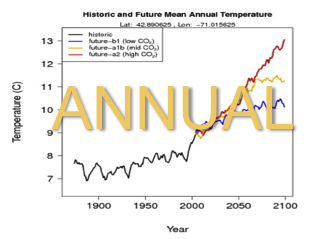Part 3: Investigate Future Climate Data
Guiding Question:
The specific question determined by the student (e.g., What does the model tell us about future rates of growth when considering global climate change?)
 ** For
background information and implementation suggestions
see the GLOBE Biomass Accumulation Model Teacher Guide**
** For
background information and implementation suggestions
see the GLOBE Biomass Accumulation Model Teacher Guide**
Definitions:
- Global Climate Models =
evaluate the physical processes occurring throughout the
Earth's land-ocean-atmosphere system. Generate predictions
extending 100 years into the future.
- Emission Scenarios = Characterize the heat-trapping gasses that we expect to find in the atmosphere based on different scenarios describing future trends in population growth, energy use, economic development, and technology use. For more information on models and emission scenarios see information from the World Meteorological Organization.
Materials:
- Computers with access to the internet
- Biomass Accumulation Model (download zip or run online from GLOBE Carbon Cycle website)
- If downloading zip file, you will also need the free iSee Player to run the model (available from iSee Systems)
- GLOBE
Biomass Accumulation Model Teacher Guide

Pre-requisites:
- Basic knowledge of climate change as it relates to
temperature, precipitation, and the carbon cycle (See Global
Carbon Cycle and Climate slides
 ).
).
Estimated Time:
- 1- 1.5 hours
What to do and how to do it:
- INTRODUCTION: Solicit students' knowledge on potential future climate changes. What changes do they expect to see in the future in their local biome? In other biomes? Use temperature and precipitation animations as a resource and to elicit student-designed mini investigations using the Biomass Accumulation Model.
- Watch Using the Biomass Accumulation Model to Explore Climate Change screencast tutorial.
- In pairs, students follow the instructions in Student Worksheet 3 (found at the end of the Biomass Accumulation Model Teacher Guide) to pose a research question, develop an investigation plan that uses the Advanced Inputs climate change dials in the model, and analyze results.
- WRAP-UP: Class discussion, presentations, etc. For ideas
on sharing findings of scientific research, see the Communicating Research Findings page.
Students may want to connect their findings with the most
recent climate change reports and write a more formal report
of their findings, which could include possible ecological
implications to that biome if those changes occurred, and
identifies new research questions.
Assessment
Assessment suggestions are located on page 7 of the GLOBE Biomass Accumulation Model Teacher's Guide. The Teacher's Guide also contains Teacher Versions of student worksheets.
